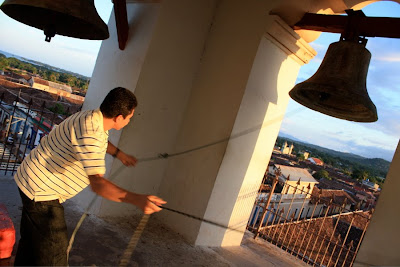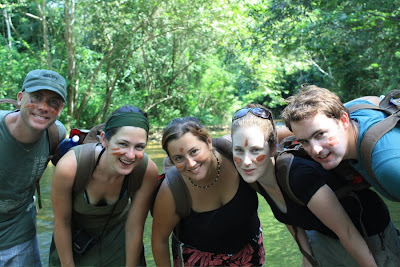This is not to say that Ometepe is a particularly unkind place, or for that matter, Nicaragua. This applies to all of Mexico and Central America so far. And don't get me wrong, we've met some truely lovely people on our travels. But when it comes to service, perhaps it was not the Spanish who got here first, but the French! They must have rocked up, trained up the locals in customer care and quietly slipped out the side door before anyone noticed.
Certainly in restaurants the French theory fits. If you behave like a Parisian, be rude, cold and stoney-faced, you get a much improved level of service. I've tried it. However, I've always been of the opinion its a risky business being rude to someone who is about to prepare your food!
Anyway, back to Ometepe. The people were no friendlier. The theory in the guide book is that they are kind because the island did not suffer the effects of Rebellion or Civil War. I find that a pretty weak theory given that the island is only an hour's boat ride from the mainland, which it relies on for produce.
The island is widely thought of as a place to relax and do nothing. However, there is so much to do. There're two volcanos to climb for a start - if you've never experienced a cloud forest before, you must climb through one! There is a 110m waterfall, natural cool springs, a lagoon, forests and beaches, some of which require a good bit of hiking to get to. We chose to climb Volcan Maderas to get a good look at a cloud forest. The volcano's crater is filled with water so there's an opportunity to swim after the climb.
The volcano itself was fantastic. Halfway up the 1300m assent, we entered the cloud. The many howler monkeys could be heard and it wasn't long before we got a glimpse of some. The noise they make is more of a growl than a howl, making them sound a great deal bigger than they are. The climb was tough at times but rewarding. Unfortunately there are no views from the top or from the lake at this time of year. When we were just about to swim in the lake, it rained heavily and it was seriously cold! We were wimps and hid under the trees!
The only negative part of the trip was our guide, a local called William. He was helpful and kind up until the point where we booked on the tour and parted with our cash, the night before. From then on he was just plain annoying and aggravating. I could write a blog dedicated solely to William. But here's a summary. Firstly he told us it wasn't going to be muddy. It was. We were caked in mud by the end. Secondly, he told us the climb wasn't steep.
It was vertical at some points. Thirdly, at 4.30 am in the morning on the bus there, he tried to get us to pay for his bus ticket. We were already paying him generously to be our guide. Fourthly, at the top of the climb, he wanted to have some of our lunch. A packed lunch that he suggested we buy from the hostel the night before. Where was his packed lunch? Never mind, I'll just steal some from my customers, he must have thought. More crucially, he didn't act like a guide, despite his supposed eight years experience at it. The walk back down was almost slower than the way up. The path was muddy, full of slippery rocks, and steep. You had to watch your every step. William just raced off and left us. At this point, I just wished we'd done this on our own to start with! Call that the final straw. We let him know what we thought of his "guiding" and from then on he sulked and didn't talk to us the entire way down. Oh well, at least now we can have a good laugh about it!
We stayed in a village called Altagracia, a tiny place with not much going on. It is peaceful (except the cockerels - how does anyone put up with owning a cockerel?) and has a main square which is being dug up and remodeled at the moment. Our guide book said it was the place to go, but Moyogalpa (where the dock is) seemed to have much more about it. Since when has our guide book ever been right?!
Overall, Ometepe wasn't as idyllic as I'd hoped but it's still a wonderful place to visit - even if only to see the way the sun sets behind the volcano - (see above).

























































